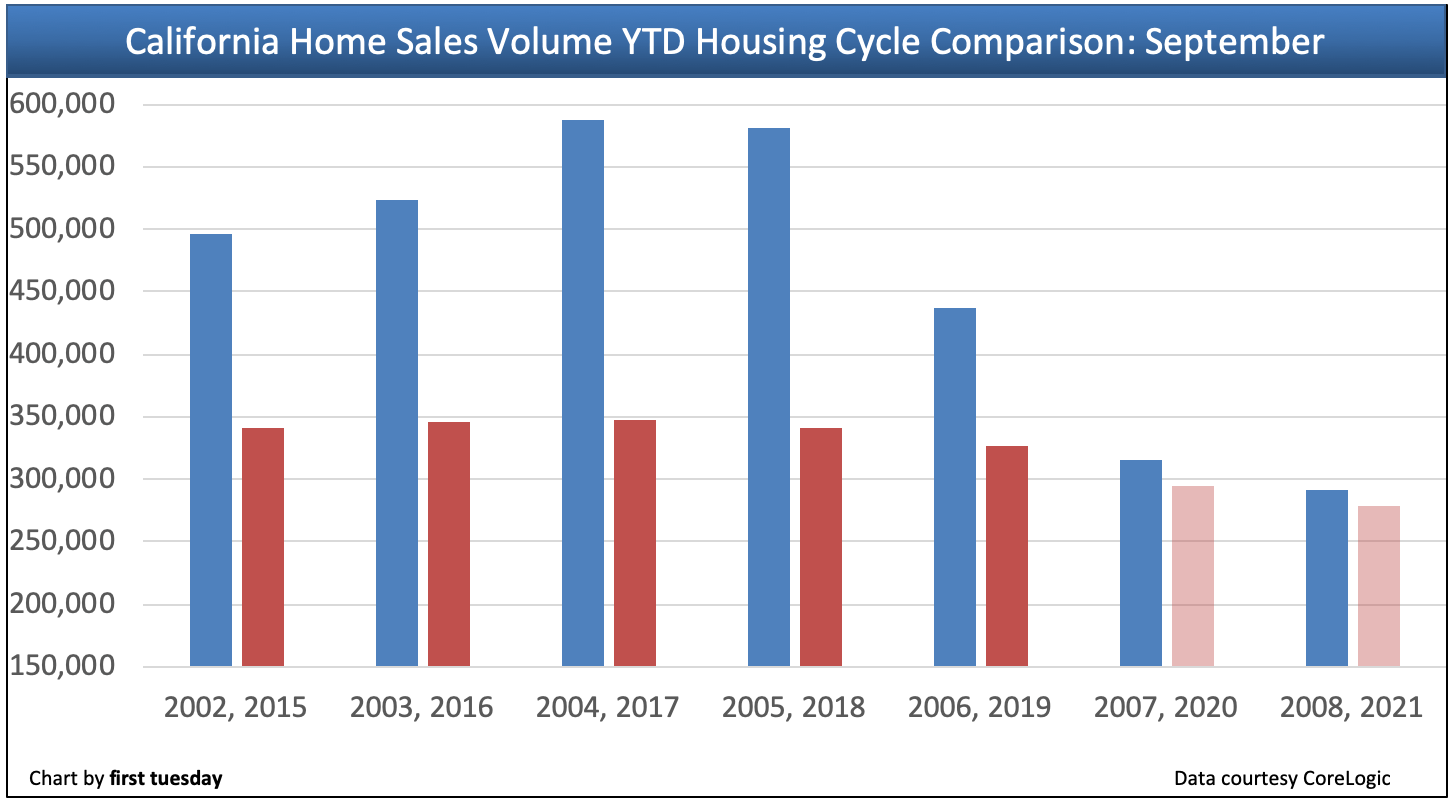326,300 homes have sold in California year-to-date (YTD) as of September 2019. This is down 4% from a year earlier.
Looking back a little over a decade when home sales were at a similar point in the past housing cycle, September 2006 YTD home sales totaled 437,100. This was down a much steeper 33% from September 2005 YTD sales volume after peaking earlier in 2005.
The current housing cycle has been less volatile than the high home sales volume and extreme home prices experienced during the mortgage feeding frenzy of the Millennium Boom. This is partly due to more stringent lending standards that have kept unqualified buyers out of the market. But it is also due in large part to a lack of urban residential construction, which has brought on a severe housing shortage.
All this results in the same volatile home prices seen during the Millennium Boom, this time accompanied by nearly flat home sales volume and the lack of predatory ARM and zero down payment lending – until recent months.
Just as home sales volume decreased through 2008, expect home sales to continue down in 2020-2021. Rising interest rates in 2018 put downward pressure on sales volume, and recessionary talk will keep home sales on their downward track in the coming months. When the recession arrives in mid- to late-2020, homebuyers will pause, waiting for prices to bottom. Once it’s clear that prices are at their bottom, likely in 2022, homebuyers will return in greater numbers, pushing home sales volume out of its depths and toward the next housing cycle’s sales volume and pricing peaks.

Chart update 12/02/19
| Sep YTD | Past housing cycle | Sep YTD | Current housing cycle |
| 2006 | 437,100 | 2019 | 326,300 |
| 2005 | 580,500 | 2018 | 340,800 |
| 2004 | 586,800 | 2017 | 347,300 |
| 2003 | 522,900 | 2016 | 345,186 |
| 2002 | 496,300 | 2015 | 341,623 |
This chart displays two housing cycles side-by-side: the past housing cycle (the blue bars) and the current housing cycle (the red bars).
Annual California home sales volume peaked during the last housing cycle — the Millennium Boom — at 753,900 in 2005. In contrast, the current cycle has seen home sales peak at 461,900 in 2017, 63% of what it was in 2005.
The general shapes of the current and last housing cycles have been the same. However, compared to pricing structure of today’s diminished home inventory for sale, home sales during the Millennium Boom were more volatile and excessive, the result of an unregulated and free-flowing mortgage market.
Thus, while September YTD sales volume decreased in 2019 and 2018, the amount of decrease has been more tempered than during 2005-2006 when the Millennium Boom was heading toward its explosive conclusion.
The reason for today’s more moderate sales volume is twofold:
- the regulations governing mortgage lending put in place following the 2008 Great Recession have kept financially unqualified homebuyers from buying; and
- residential construction has occurred at a glacial pace compared to the Millennium Boom years.
For example, compared to 2018, the 2005 construction peak was 60% higher for SFR construction starts, amounting to 92,100 more homes built in the single year of 2005 compared to 2018. In contrast, an annual pace of roughly 200,000 starts is needed for several years to bring the housing supply into line with California’s housing needs.
To complicate the supply of inventory, during 2012-2013 speculators swarmed the market, scooping up real estate owned property (REOs) and other low-priced homes. Sometimes they flipped, but a meaningful number remain absentee owners today, renting to former and would-be homeowners. As evidence, the share of SFR rentals to ownership has jumped in all of California’s major metros since the Millennium Boom peak.
The result is a reduction in inventory and fewer homes available to lender-approved homebuyers.
California’s housing shortage impacts
Residential construction has increased almost every year in California’s major metros since the housing market bottomed in 2009-2010. But at the same time, the state’s population has increased at a faster rate.
While much of this increase is due to more births than deaths (which don’t always result in new households), the rate of household formation exceeded new construction in all of California’s major metros during 2010-2015. Construction has since rebounded to catch up with household formation in some metros, though it is still lagging in Riverside, Sacramento and San Francisco.
Related article:
Where in California new construction is keeping up with population growth
Put another way, California’s total number of construction starts in 2018 was 31% below the historical average, calculated each year since 1960.
The hardest hit groups have been:
- seniors;
- low-income households; and
- first-time homebuyers.
The senior housing crisis is one that is growing on a daily basis as California’s Baby Boomer population continues to age and retire. While senior homeowners have the option to either modify and age in place or sell and downsize their homes to suit their changing living needs, senior renters are faced with debilitating rising rents, contrasted with their set retirement incomes.
The result has been a significant jump in senior homelessness. In Los Angeles, the senior homeless population jumped 22% in 2018 alone, and growing.
Low-income homebuyers and renters alike have been hit hard by the housing shortage. This is because when builders invest in new construction, it is primarily where the profits are, in the higher tiers. Builders only venture into the low tier when local governments provide generous density, subsidies and fast-track incentives.
There are roughly 2.1 million renter households limited by very low or extremely low incomes. In contrast there are just about 700,000 housing units with suitably low rents, according to the California Housing Partnership. This leaves California short 1.4 million housing units for this population.
With little to no savings capacity, likely first-time homebuyers find it difficult and often impossible to break into today’s undersupplied housing market. Whereas during the Millennium Boom, when new housing was popping up on every (suburban) corner, today’s growing population of first-time homebuyers are competing for the same, shrunken inventory, available at ever-increasing prices.
Real estate professionals impacted by the housing shortage
As real estate professionals are the gatekeepers for entry into real estate ownership, you have undoubtedly felt the impacts of California’s housing shortage, which has kept home sales volume down.
When home sales volume is low, there are fewer transactions available per licensee, and agent and broker incomes suffer dramatically from fewer transactional fees. In places where agents are completing dozens of transactions a year, the loss of a few home sales doesn’t make a big difference over the course of a year. But for an agent who expects to complete only 5 or 7 sales in a year, any sale that falls through can be catastrophic.
In fact, according to a recent survey of U.S. agents, 46% of active agents report taking on a second job to supplement their sales income to make a living.
California’s active agent population declined 35% during the fallout from the last housing cycle. Real estate agents and brokers who want to continue practicing and survive the coming lean years will need to get creative. This includes:
- expanding your practice to include related income opportunities like:
- property manager;
- foreclosure and short sale specialist; and
- 1031 exchange specialist;
- overproduce when possible by increasing your marketing efforts and broadening your FARM;
- become a broker and increase your influence and income base; and
- purchase investment property seller-financed at the bottom of the market, by yourself or by forming a real estate syndicate and pooling investor money.
California’s slow home sales volume will continue for the next two years, at least. Even when it does rise again, it won’t grow to the elevated heights of the Millennium Boom anytime soon. The agents who survive the coming recession will be those most creative, resourceful and diligent among them.
Related article:













